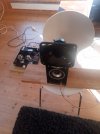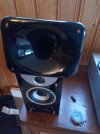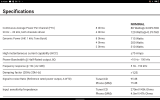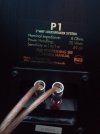-
WANTED: Happy members who like to discuss audio and other topics related to our interest. Desire to learn and share knowledge of science required. There are many reviews of audio hardware and expert members to help answer your questions. Click here to have your audio equipment measured for free!
You are using an out of date browser. It may not display this or other websites correctly.
You should upgrade or use an alternative browser.
You should upgrade or use an alternative browser.
Why do so many prefer the sound of "Class A" amplification vs. "linear" amps?
- Thread starter rsoffer
- Start date
It make sense that a linear output amp with no switching distortion, matched pairs for equal gain left and right and very high capacitance for smoothing and storage should sound better. How much better is one another thing. I've heard one class A amp that sounded better. All others where just another amp or another power amp.You guys know darn well class A and A/B are all about the PRaT, chocolatey mids, airy highs, fast bass and the ultimate, velvety vocals. Not that I'm stirring the pot.........
This is somewhat what I suspect. More harmonic distortion = warmth or whatever else they're describing. But is this actually audible?
You can measure two recordings and then run it through DeltaWave to see if you have a PK Metric that meets the threshold of -50 dB.

Measuring the "sound signature" of two different integrated amplifiers.
@KSTR figured out that the left and right channels were swapped during recording! Presumably this must have been the case when listening too! The calculations had been done in stereo. This changes the numbers and shows smaller changes between amps when fed directly but still has a change...
 www.audiosciencereview.com
www.audiosciencereview.com
If anything, using a regular microphone instead of the amplifier itself will up the challenge of detecting a difference.
Edit: and if you trust Accuphase's own measurements, you can see the difference between their A/AB switchable amplifier.
Sadly, I sold this P-266 before I got my test gear, but I did replace it with the Marantz PM-11s2 which did very well here:

3 Generations of Marantz flagship integrated amps measured
Three Generations of Marantz flagship integrated amps measured (updated PM-10 test!) One of the biggest challenges with amplifier testing is shipping the gear without damage. We've already seen how the JBL SA600 from 1965 pretty much has an amplifier section that performs similarly to the JBL...
 www.audiosciencereview.com
www.audiosciencereview.com
Last edited:
Personally all the differences I thought I was hearing were not there in level matched “blind” (my daughter made the changes so I didn’t know which I was listening to) comparisons.I'm more curious, as I've never owned a class A amp and have never been able to A/B test them myself.
They point to the sound being more "open", "warmer", "dynamic", less "sterile".
For tube amps, it seems more reasonable there would be a difference. That extra distortion which colors the sound. For class A, are they essentially hearing less of the same phenomenon?
In the above videos, Mid-Fi guy goes into great detail listing out the differences between various solid state amps. Part of me finds it very hard to believe that he's simply imagining all of it. What do you guys think is going on there?
Josh Valour does a fairly unscientific A/B test of the A90 vs. A90D, but it's still a data point showing some audible differences.
What's going on here? Are so many audiophiles who spend time with this equipment on a daily basis simply imagining all of it?
The placebo effect is also very strong - particularly with fancy looking expensive stuff. People are extremely inclined to believe expensive stuff is better, and are heavily encouraged into this belief by reviewers and dealers.
In reality a small increase in level is heard as more clarity rather than louder and IMO a lot of demos rely on this fact to sell punters more expensive kit
I have enjoyed Class-A, class AB, Class-D and hybrid amplifiers and the only thing that really stood out with the class A (two Krell KSP 200B amps driving active Apogee Diva speakers) was how hot they made the listening room.
They sounded fine but I was equally happy with a Class AB Spectral DMA180 in another system.
Even though I'd use class D for my horns if the J2 ever dies, it does warm the room nicely in this nippy weather.
Those bad boys are supposed to get amps hot.Apogee Diva speakers
Just got another on in yesterday and same thing. Over 250 ohm headphones and it goes into class A automatically. In standby it's warm, but I just took the DT880 600ohm out for a spin in high gain mode and it did feel less warm the whole time than in standby. It is nice being able to stay in medium gain even on the 600 ohm Beyers, just need high for replaygain, prevolume war recordings, or equalizing with a big preamp reduction. With the 880's I tried to reach the end of the volume wheel to see in medium gain and the last few notches I got the "Danger Will Robinson" alarm as it got too loud. It's nice not having to buy balanced cables ever again.Slightly off topic. I have a Topping A30 Pro that at lower volumes runs class A. It gets really warm. At high volumes it run with just a touch of heat.
Sokel
Master Contributor
- Joined
- Sep 8, 2021
- Messages
- 6,112
- Likes
- 6,182
Class A is famous in Mic's preamplifiers.
Even my cheap E-MU works that way.I owned couple of amps too,one of them is still one of favorites of all time even if I moved on and owned 5-6 class D from then on.
(never heard the famous warmth though,was rather neutral according to my taste.)
Even my cheap E-MU works that way.I owned couple of amps too,one of them is still one of favorites of all time even if I moved on and owned 5-6 class D from then on.
(never heard the famous warmth though,was rather neutral according to my taste.)
DanielT
Major Contributor
Tube amplifiers are operated in different classes, in case anyone is wondering about the concepts.For tube amps, it seems more reasonable there would be a difference. That extra distortion which colors the sound. For class A, are they essentially hearing less of the same phenomenon?
Finally, all single-ended amplifiers are Class A. Push-pull amplifiers are predominantly Class AB, but they can be Class A, AB, B, and a host of others.
General about amplifier classes:
Power amplifier classes - Wikipedia
For more details, you can ask more knowledgeable people than me here at ASR.
Last edited:
DanielT
Major Contributor
I am attaching some pictures. Experiment I did. A single end class A tube amp, 6.7 W that I borrowed and sold on behalf of a friend. Absolutely no problem running compression drivers only. But the drivers have 108 dB sensitivity.
On the other hand, I tested 89 dB sensitive two-way speakers with an 8 inch bass element in them. The same tube amp, single end, class A 6.7 W vs class AB transistor of 80 W. At low volume then the tube amp managed to follow along but then when I turn on the volume all the more.. nop. I saw with my own eyes that the power-poor class A amplifier was literally unable to pump the bass driver, so it really wasn't imagination. Now it didn't sound bad (well kind of), it just almost didn't sound. Had it been a transistor-based class A amplifier of 6.7 W that was driven beyond its capability in this way, well I don't know. I would probably then have heard rather bad-sounding clipping from that amplifier, or..? I guess that anyway.
Now it didn't sound bad (well kind of), it just almost didn't sound. Had it been a transistor-based class A amplifier of 6.7 W that was driven beyond its capability in this way, well I don't know. I would probably then have heard rather bad-sounding clipping from that amplifier, or..? I guess that anyway.
Edit:
I used a NAD's pre amp part and turned the bass tone control up to max I should add. That plus with bass pumping techno music to test. With class A, tube amp maybe muddy sound, but above all it couldn't barely drive the 8 inch basses when I turned the volume really high.
On the other hand, I tested 89 dB sensitive two-way speakers with an 8 inch bass element in them. The same tube amp, single end, class A 6.7 W vs class AB transistor of 80 W. At low volume then the tube amp managed to follow along but then when I turn on the volume all the more.. nop. I saw with my own eyes that the power-poor class A amplifier was literally unable to pump the bass driver, so it really wasn't imagination.
Edit:
I used a NAD's pre amp part and turned the bass tone control up to max I should add. That plus with bass pumping techno music to test. With class A, tube amp maybe muddy sound, but above all it couldn't barely drive the 8 inch basses when I turned the volume really high.
Attachments
Last edited:
Some are class C. No, you wouldn't want to listen to thoseFinally, all single-ended amplifiers are Class A.
DanielT
Major Contributor
Probably not but for the sake of curiosity it would have been interesting.Some are class C. No, you wouldn't want to listen to those
OT:
Class C seems to be used for RF transmitters:
Class C

Class-C amplifier
In a class-C amplifier, less than 50% of the input signal is used (conduction angle Θ < 180°). Distortion is high and practical use requires a tuned circuit as load. Efficiency can reach 80% in radio-frequency applications.[11]
The usual application for class-C amplifiers is in RF transmitters operating at a single fixed carrier frequency, where the distortion is controlled by a tuned load on the amplifier. The input signal is used to switch the active device, causing pulses of current to flow through a tuned circuit forming part of the load.[16]
Power amplifier classes - Wikipedia
Yes, it's simple and efficient. As long as you can tune for a narrow band of frequencies, distortion is good enough for many purposes. For audio? It would probably sound like everything was robot musicProbably not but for the sake of curiosity it would have been interesting.
OT:
Class C seems to be used for RF transmitters:
Class C

Class-C amplifier
In a class-C amplifier, less than 50% of the input signal is used (conduction angle Θ < 180°). Distortion is high and practical use requires a tuned circuit as load. Efficiency can reach 80% in radio-frequency applications.[11]
The usual application for class-C amplifiers is in RF transmitters operating at a single fixed carrier frequency, where the distortion is controlled by a tuned load on the amplifier. The input signal is used to switch the active device, causing pulses of current to flow through a tuned circuit forming part of the load.[16]
Power amplifier classes - Wikipedia
en.wikipedia.org
DanielT
Major Contributor
He he.Yes, it's simple and efficient. As long as you can tune for a narrow band of frequencies, distortion is good enough for many purposes. For audio? It would probably sound like everything was robot music
One last OT from me in this thread:
General tip for those reading this thread. Visit a radio museum. It's interesting with radio and sound history, I think:
Museum Finder, Guide, Radio, technical museums, list | Radiomuseum.org
Museum Finder is a Guide to find Radio museums, technical museums etc. There is a list and detail pages.
www.radiomuseum.org
Another tip, this thread, if we're talking audio history:

The Truth About Tape Recorders
By the end of the 80’s it was obvious that conventional reel to reel audio tape was pretty much dead as a domestic music format. What was a more than competitive technology in the 60’s and 70’s with respect to fidelity had morphed into the compact cassette but that wasn’t enough to save tape...
 audiosciencereview.com
audiosciencereview.com
Cross over distortion is indeed visible as a bunch of harmonics to up to 20 kHz and often far beyond...
Here a standard but well powered LM3886 chip amp:

And here the same LM3886 amp tailored as a composite amp (CA amp):

Same clean-up for IMD! IMO the higher harmonics are masking fine detail. There is clearly a remarkable difference between both amps soundwise. I.e. the CA amp sounds more relaxed and reverb of well recorded albums has longer tails. This is the same you will experience with a well designed class-A amp. However most class-A marketed as class-A is only partly working in class-A. Such amps sounds pretty well at moderate levels but when you cross the the borders of class-A bias you have TWO cross-over points! One at the plus side and one at the minus side.
Here a standard but well powered LM3886 chip amp:
And here the same LM3886 amp tailored as a composite amp (CA amp):
Same clean-up for IMD! IMO the higher harmonics are masking fine detail. There is clearly a remarkable difference between both amps soundwise. I.e. the CA amp sounds more relaxed and reverb of well recorded albums has longer tails. This is the same you will experience with a well designed class-A amp. However most class-A marketed as class-A is only partly working in class-A. Such amps sounds pretty well at moderate levels but when you cross the the borders of class-A bias you have TWO cross-over points! One at the plus side and one at the minus side.
I think a lot of people that use class A for lower efficiency speakers are experiencing peak clipping. Most class A amps just don't have the oomph required. Maybe that accounts for the "smoother" sound.
Class A are seldom very powerful.Duh, I don't think "oomph" is not what sets class-A apart from class-AB. If both are well designed the only difference sound-wise, is cross over distortion and the lack thereof. And practically also your electricity bill
True, they are not suited as a power house in general. They excel in the mids and highs, so use them for that only in a high-end set-up. The lows don't favour from class-A. In that frequency region feedback is usually that high, cross over is suppressed pretty well with regular class-AB.
I myself have always been a big fan of class-A. Long time ago I build a John Linsley Hood Mosfet 80W amp biassed in class-A. One of my finest amps ever. But idling at over 250W! Today I use a composite amp idling at a 13 watts for 2x 80W/channel, for the mids/highs and UcD class-D for the bass region. For me class-A for power amps is something of the past anyway. But not the sound of it!

25
I myself have always been a big fan of class-A. Long time ago I build a John Linsley Hood Mosfet 80W amp biassed in class-A. One of my finest amps ever. But idling at over 250W! Today I use a composite amp idling at a 13 watts for 2x 80W/channel, for the mids/highs and UcD class-D for the bass region. For me class-A for power amps is something of the past anyway. But not the sound of it!
25
Similar threads
- Replies
- 126
- Views
- 28K
- Replies
- 6
- Views
- 2K
- Replies
- 4
- Views
- 993
D
- Replies
- 1
- Views
- 2K




